David Borrington in The Dickson Poon School of Law
David Borrington was The Dickson Poon School of Law’s first Honorary Artist in 2015, exploring art's relationship to contemporary political events through prints and etches on both a small and large scale.
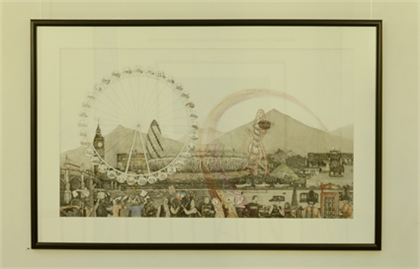 Honorary Artist scheme
Honorary Artist scheme
The Dickson Poon School of Law’s Law, Arts and Culture Programme, which includes an Honorary Artist scheme, was established after the School’s move to Somerset House's East Wing in 2012. The scheme started as a way of making this unique space appropriate for the School, its staff and its students. However, it has since developed into a series of projects that have sought to establish an active engagement with law’s relationship to art and culture.
The Honorary Artist projects have given the School and its community a platformfor focusing this dialogue, while also offering students a wide selection of events and smaller projects that have developed out of the scheme. Fostering relationships with a variety of artists working with ideas and themes related to law has ultimately enabled the School to develop the longevity of the Law, Arts and Culture Programme while diversifying the kind of experiences and interactions it is able to offer its students, staff and alumni.
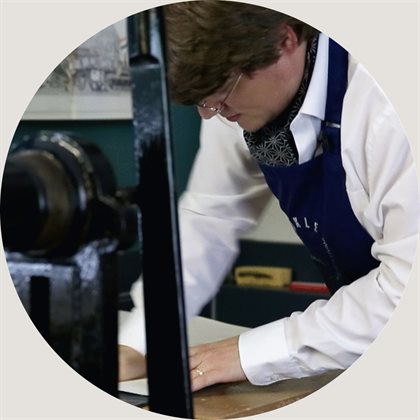
David Borrington is an artist who works with etchings and printmaking to develop highly detailed pieces, presenting sweeping depictions of contemporary political and cultural events. The School exhibited a range of pieces depicting references to diverse topics like Pinochet’s 1973 coup in Chile to the 2012 London Olympic Games. What unites these works is a cohesive essayistic style that allows David to cultivate historical allusions, moments of gallows humour, and scathing social commentary across very broad canvases.
As such, David employs different registers from the satirical to the controversial, seeing the various strands of his work as being focused by a thorough search for objectivity. The role of reportage is central to this practice as David deploys a sceptical approach to the issues he presents beyond the bias, propaganda and hypocrisy he finds in the mainstream media. In this sense he feels an allegiance to what one might consider a legal approach, evaluating the evidence found in the world around him and presenting it as objectively as he can.
Whether one agrees with the artist’s vision or takes offence, a critical judgment is always elicited and a stand must be taken. David considers this kind of critical response to be a fundamental prerequisite for the establishing of any active form of engaged citizenry and thought. It is this critical discourse that David identifies in the progressive study of law as his work constantly searches for a sense of insight in a world that is wrought with complexity. As such, his work demarcates a space where the critical processes of art and law might converge.
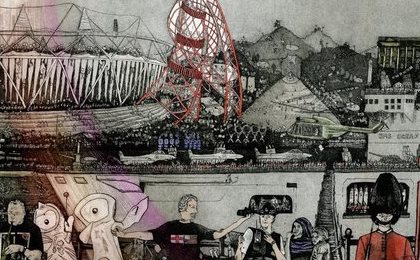
In And Did Those Feet In Ancient Time, LONDON 2012 (above), for instance, we get various scenes of celebration and sporting rivalry alongside looming references to warfare and the violence implicit in any geopolitical landscape. The work focuses a sense of absurdity and juxtaposition that forces the viewer to reckon with the broader duplicities the piece infers. This is characteristic of an artist with deeply egalitarian principles.
And Did Those Feet In Ancient Time, LONDON 2012 gives a view of a particular historical situation filtered through a highly idiosyncratic perspective that demands a dialogue with the viewer. However, there is another dimension to this act of reportage that places David’s work far beyond being merely controversial. In presenting illustrations that are highly detailed, with various conflicting and sometimes shocking depictions of conflict and injustice, the audience is implicitly asked to critique the various juxtapositions and problems his work presents.
The constant tension posed between the part and the whole in his larger works is also indicative of the way David seeks to use this particular style of reportage in order to elicit an active political discourse with his viewer.
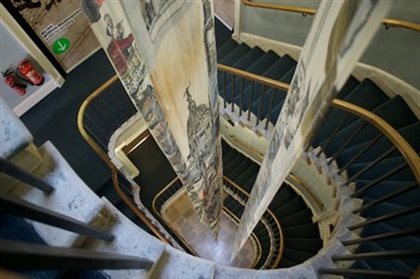
For pity is the virtue of law
This can be seen in a work David contributed for the School’s recent project, For pity is the virtue of the law that coincided with King's exhibition By me William Shakespeare: a life in writing presented in the Inigo Rooms. David designed and created three banners that were hung in the stairwell of the law school, outside the exhibition space.
Working with one of the School’s academics, Professor Lorenzo Zucca, David chose three topics to work on for each banner: allusions to Shakespeare’s work in English legal and political life, a copy of Shakespeare’s Complete Works that was passed around Robben Island and a view of legal London related to Shakespeare’s life and times. Professor Zucca teaches a module on the legal aspects of Shakespeare’s work and this project was designed in support of his research.
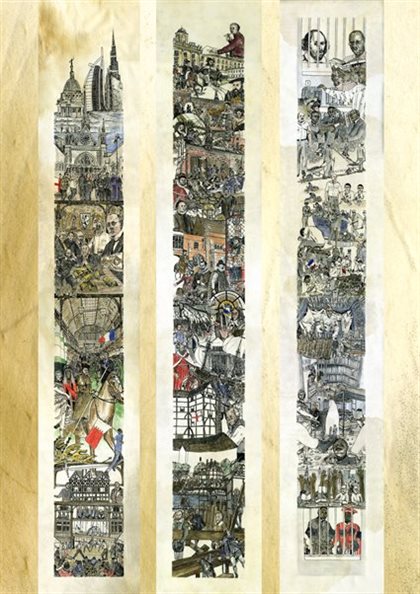
The first banner in the series, focusing on English legal and political life, draws on ten of Shakespeare’s plays, weaving references into current affairs from the crisis in Syria to the rise of the far right in the UK. For example, the banner begins with a reference to a version of Hamlet that was staged at a refugee camp in Calais earlier this year. David focuses on the famous play-within-a-play scene, showing certain key political figures looking over the performance with ambivalence. The banner then displays similar allusions taking place in different locations such as outside the Royal Courts of Justice and the Houses of Parliament, where the spectacle of theatre, the law and current affairs take place on grander stages.
The second banner in the series presents a view of legal London while bringing together the formation of the Globe Theatre and the history of Somerset House. It depicts the Inner Temple, Middle Temple, Grey’s Inn and Lincoln’s Inn, while also presenting famous events and figures related to these institutions. These include people associated with the Inns, such as Sir Thomas More and Sir Walter Raleigh to Inigo Jones and William Chambers, two of Somerset House’s most well know architects.
David also chose to explore the Robben Island Bible, a copy of Shakespeare’s plays that was shared among the inmates of the notorious South African prison. Upon the end of Apartheid, each former inmate was asked to sign their names next to their favourite passages and the book is now exhibited all over the world. The third banner focuses on the history of Robben Island, once again drawing on Shakespeare’s prefiguring of ideas that would help shape legal and literary history.
The original design sketches of the banners were exhibited in on Floor -2 of The Dickon Poon School of Law in Somerset House's East Wing. These have been loaned to the School by David to coincide with the presentation of his other pieces that are on display throughout the building. These particular works were drawn on vellum, a parchment that was prevalent in Shakespeare’s time and which is still used in the government’s drafting of bills.
About the artist
David Borrington's work explores, and is a direct response to, fast-moving current social and world events. Despite being severely dyslexic, his natural scepticism and innate sense of justice leads him to question propaganda of all kinds but most especially that disseminated by 24/7 news streams and corrupt elites. While technology helps him overcome his disadvantages in writing and reading, his research benefits from an extremely precise long-term memory and visual recognition (found in only 0.02 per cent of the population) that puts him in a unique position to create and analyse his surroundings within the visual arts, a truly unique perspective on the world.
Since graduating from the Royal College of Art in 2008, David co-founded the Dekkle Fine Art Print Studio in Baldock, Hertfordshire, with his wife Louisa. As well as being the first Honorary Artist in The Dickson Poon School of Law at King’s, he is also an Artist fellow in the Lawful Government of Hawaii and in 2009 he was a Research Fellow at West Dean College in Sussex. He has exhibited nationally and internationally since 2004 and has published in the Art of England journal.